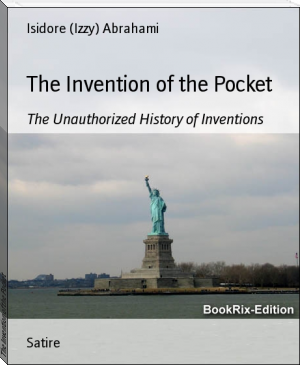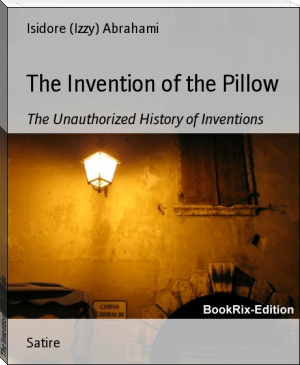The Invention of the Pocket by Isidore (Izzy) Abrahami (different ereaders .TXT) 📖

- Author: Isidore (Izzy) Abrahami
Book online «The Invention of the Pocket by Isidore (Izzy) Abrahami (different ereaders .TXT) 📖». Author Isidore (Izzy) Abrahami
THE INVENTION OF THE
P O C K E T
English: Pocket
Dutch: Broekzak
French: Poche
German: Hosentasche
Latin: Rigoris Mani
Ancient
Greek: Rigere Mekoneion
There is a great dispute among the nations of the world, as to the invention of the pocket.
The controversy about its origin has been intensified since, in 1986, Countess van Limburg-Stirum, (nee: Dolly van Lynden) lectured about the pocket in "La Grand Societe de Berne" in Switzerland, in "La Fondation Europeanne de la Culture" in Germany, in the "Haagsche Club" in Holland and in "The Institute for Modern Thought" in New York. In her well publicized lectures, she contended, contrary to any other theory, that the pocket has been invented by Harun al-Rashid in 790 A.D. and further perfected by Ibrahim Ibn-Aghlab some 20 years later.
This alone, wouldn't have sparked such a debate if the Countess, in her closing remarks, wouldn't have claimed that because the House of Orange and the U.S. Republican Party are the direct descendants from the dynasty of al-Rashid and Ibn-Aghlab, the pocket should be considered to be the invention and the property of the House of Orange and of the U.S. Republican Party.
But, the Countess was in error.
Harun al-Rashid didn't invent the pocket, thus it couldn't belong to the House of Orange, or to the U.S. Republican Party. Mr. al-Rashid only invented the pan-holder (Sometimes in Dutch: Pannelap. German: Toplappen) which, indeed, is the indisputable property of the House of Orange and of the U.S. Republican Party.
The data we've obtain confirms only the fact that the pocket came to being through the evolutionary process, starting with the pan-holder. Thus, the account of the invention of the pocket wouldn't be complete without a few essential facts about its origin: the pan-holder.
In 783 A.D., Harun al-Rashid invented the pan-holder the day his mistress badly burned her fingers, having lifted a metal pan containing boiling water.
For seven hundred years, the pan-holder, was used as pan holder.
In 1521, the German politician Dr. Prof. Martin Waldseemuller, married a woman who, in their wedding night, suffered a stroke that impaired her memory considerably. Since that day, she never remembered to wear the pan holders, and consequently, she would repeatedly burn her fingers. In the course of the next few years, her fingers had become hardened and coarse. The professor was in great agony. He loved his wife dearly, but detested her massages. He decided to travel and meet intellectual people who could give him some advice and help him in his ordeal.
In the small village of Duivendrecht, in Holland, he met a certain Joop Olie de Jong van Beek en Donk, who advised him to fasten the pan-holders on both sides of his wife's dress and to attach small chimes on each pan-holder. "When your respected wife, walks in the kitchen," Mr. van Beek en Donk, told him, "she'll be hearing the pan holders chime, and will never again forget to use them."
This was the beginning of the evolution of the pocket. The exact date is recorded to be Sep. 4, 1526.
On his return to Germany, the professor found his wife dead. She had committed suicide leaving him a note that reads: "You hate my fingers. You are sick!"
Hearing of Dr. Prof. Martin Waldseemuller's wife's suicide, Joop Olie de Jong van Beek en Donk, from Duivendrecht, was broken hearted. He left his farm, having decided to dedicate his life to promoting his invention, namely, the fastening of the pan holders, including the chimes, on both sides of the woman's dress.
It is now clear that he was mistaking too. What he was promoting
was in fact, the evolution of the pocket.
In the next fifty years, almost all women of good standing, had the pan holders attached to their dress.
The first woman to use the pan-holder as a pocket was Mary Queen of Scots.
It was in 1587 that Mary Queen of Scots, was executed. As usual, the politicians covered up the real reason for her execution. The fact is, that she was discovered to have stolen five pieces of gold from her husband's secret chest, and having sewed the pan holders into her dress, she had hid the gold pieces between them.
At this precise moment, the pocket came into being.
Almost instantaneously, the use of the pan holders as pockets became the women's national fad, and spread like wildfire, into all the nations of the world.
It didn't take more than a year for the politicians in every country, to pass a law prohibiting the use of the pocket. Their rational was that the pocket made mockery of family life, and if the pocket would be made legal, the relationship between men and women would deteriorate considerably.
For thirty years, the pocket went underground. Many a woman would were them secretly and never in public. The few who were found wearing pockets, were hastily executed.
In December of 1617, the world's national rulers received a memorandum signed by Maximilian I, the Duke of Bavaria, advising them to legalize the pocket and to put a high tax on anyone who wears it.
"It would be the greatest source of income, we've seen so far." He wrote.
Within a year, a law was passed legalizing the pocket. A heavy tax was put on the wearers, with a yearly increase of 37.6%, based on the rulers' calculation of the pocket's appreciation.
The new tax was named: Pocket Money. (Dutch: Zakgeld. German: Taschengeld. French: Argent Du Poche.)
Three years later, the wearing of a pocket, for anyone over the age of 12, was made compulsory by law.
It wasn't until the assassination of Rasputin, on Dec. 30, 1916, that the Pocket-Money tax was abolished. During the three hundred and sixteen years of its existence, the political rulers, all over the world, added to their income, the equivalent of some nine hundred billion dollars.
The facts are clear. The pocket wasn't invented by any one person. The invention of the pocket was sort of a team work, beginning with Harun al-Rashid in 790 A.D., continuing with Dr. Prof. Martin Waldseemuller in 1587, and with Joop Olie de Jong van Beek en Donk in 1526, ending with the final pocket of Mary Queen of Scots in 1587.
And that's the detailed, exact story of how, why and by whom the pocket, as we know it today, was invented, and how it had evolved throughout the ages.
Publication Date: 07-19-2010
All Rights Reserved





Comments (0)